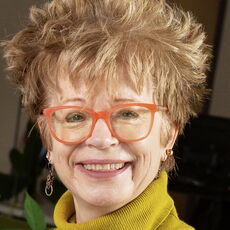
How to use kinesthetic mapping for kick-ass presentations
A recent email read, "I have a high stakes speech in a month and I don't know what to do. Can you help me?”
Because Gmail flagged this message as possible spam, I hesitated before responding. But there was something in the tone that called to me. So I agreed to a preliminary Zoom call with Darrell.
As a former football player, newly married and recently relocated from Texas to Boston, Darrell had grappled with significant changes prior to contacting me. He had worked for this multinational pharmaceutical company for about six months, and was slated to give the preliminary presentation at a conference in Florida that would inform the entire company of new developments in customer service.

He was made aware that his performance in this presentation could make or break his career. The event was a month away. Talk about pressure!
We had five sessions to get Darrell into shape.
As he shared his speech with me in our first session, I noticed Darrell spoke very rapidly. I also saw that he was swaying back and forth in one place and seemed not to know what to do with his hands. However, his talk was very well researched and organized, with effective football metaphors that brought to life his call for stronger teamwork in customer service.
The first piece of feedback I gave him was based on these positives. But I could see why the reaction he'd received from his colleagues had to do with his “moving around too much."
Movement in presentations is a problem if it's random and unfocused. Darrell had been told to speak from one place and stop moving. I disagree strongly with this dated advice. Effective use of space in presentations — called "kinesthetics" — can help bring complex material to life for the speaker and the listeners. I needed to help Darrell focus and strategize his instinct to move.
We identified five areas of the stage that he could use at points throughout his speech, indicated by orange duct tape. As he changed topics, he would move to a different piece of tape. He could use silence to move between, or he could talk and walk simultaneously.
I also had him jog onto center stage to begin his talk. And we strengthened the football metaphors by hand gestures: the IT team "throws the ball" to the sales team "receivers", etc.
This way, Darrell could use his own authentic love of the game in a way that kept his audience engaged while giving him physical and gestural choreography. Also, in working within the kinesthetic map for his talk, Darrell actually started to slow his verbal delivery.
As we worked together in this way, Darrell dropped his anxiety and started to have fun. After our fourth session, he admitted that he was actually looking forward to the speech.
To recap the process:
- Factor in the size of the stage
- Designate up to five areas to use in a pattern: diamond, triangle etc.
- Mark with tape
- As you move from topic to topic, find a different piece of tape to stand on
- Vary the pattern of your movement
The evening after his presentation, I received a text: "News to share!"
When we connected by phone, I could hear the joy in his voice: "It was fun! Everyone said I was a 'natural'! (His boss) told me we'd talk about my promotion next week! I can't thank you enough!"
The upshot of this story? It's so tempting to focus on the content and verbal delivery for a presentation. But once we can give our very natural need to move a kinesthetic map onstage, we can tune into our content with our physiology. This single element can help us kick that presentation ball out of the park.









0 Comments